Dairy Cultures Market Research, 2032
The global Dairy Culture Market Size was valued at $883.2 million in 2022, and is projected to reach $1,473.2 million by 2032, registering a CAGR of 5.8% from 2023 to 2032. Dairy culture refers to microorganisms, primarily bacteria and sometimes yeast, used in the production of fermented and cultured dairy products. These cultures play a crucial role in the transformation of milk into products like yogurt and cheese, enhancing taste, texture, and quality. Starter cultures, consisting of specific microorganisms, initiate fermentation, converting lactose into lactic acid and contributing to the unique characteristics of the final dairy product. The culture manufacturing process involves obtaining a commercial culture, known as a master culture, from a laboratory, which is then used to produce mother cultures for broader application in dairy processing. Cultured dairy products, such as yogurt, are created through the fermentation of milk with lactic acid bacteria, contributing to their distinct flavors and health benefits.
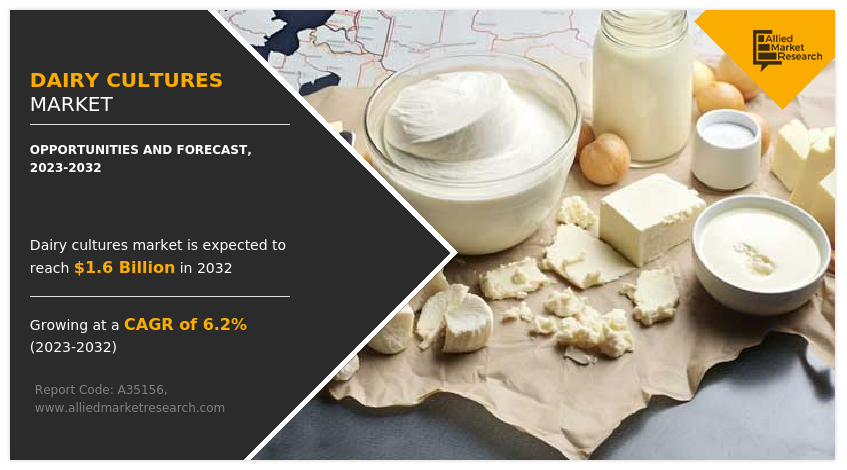
Market Dynamics
Consumers' increasing interest in health and wellness
Consumers' increasing interest in health and wellness has significantly fueled the demand for fermented dairy products in recent years. Fermented dairy products are rich in probiotics, live beneficial bacteria that promote gut health. This heightened awareness of the importance of gut health and its impact on overall well-being has driven consumers to incorporate more fermented dairy items into their diets.
Fermentation is a natural process that enhances the nutritional profile of dairy products. It involves the breakdown of lactose, the sugar present in milk, into simpler compounds, making these products more digestible for individuals with lactose intolerance. This aspect has broadened the consumer base for fermented dairy products, attracting those who might otherwise avoid traditional dairy.
Moreover, fermented dairy products, such as yogurt, kefir, and cultured milk, are known for their distinct flavors and textures, contributing to a diverse and enjoyable culinary experience. This sensory appeal has played a pivotal role in the growing popularity of these products, as consumers seek not only nutritional benefits but also a satisfying taste.
Growing trend towards natural and minimally processed foods
The global trend towards natural and minimally processed foods has further propelled the demand for fermented dairy. Consumers are increasingly drawn to products with clean labels, and fermented dairy aligns with this preference as it involves natural processes without the need for extensive additives.
The rise of plant-based alternatives has also influenced the demand for fermented dairy. Manufacturers are introducing plant-based fermented products to cater to the growing population of individuals embracing vegetarian and vegan lifestyles. This expansion into plant-based offerings demonstrates the adaptability of the fermented dairy market to evolving consumer preferences.
Supply chain disruptions
However, supply chain disruptions represent a significant restraint in the dairy culture market. The intricate network of processes involved in dairy production, from sourcing raw materials to delivering the final products to consumers, is vulnerable to various challenges. External factors, such as natural disasters, transportation issues, and geopolitical events, can disrupt the smooth flow of the supply chain, impacting the timely availability of essential ingredients and finished dairy culture products.
The dairy industry relies heavily on a consistent and efficient supply chain to ensure that production meets demand. Any interruptions in the supply chain can lead to shortages, affecting both producers and consumers. For example, if there are disruptions in the transportation of milk or other key ingredients, dairy culture manufacturers may face delays in production, leading to potential stockouts in the market.
Prevailing health and nutrition trend
The dairy culture market is experiencing a significant upswing driven by the prevailing health and nutrition trend. Consumers, now more than ever, are prioritizing their well-being, leading to a surge in demand for health-conscious food choices. In this context, dairy products, often recognized for their nutritional value, have become central to meeting these evolving consumer preferences.
One key aspect contributing to the growth is the increasing awareness of the health benefits associated with dairy consumption. Dairy products are rich sources of essential nutrients, including calcium, vitamin D, and protein, which play pivotal roles in maintaining bone health, supporting immune function, and promoting overall well-being. As individuals become more conscious of the importance of a balanced diet, dairy products are gaining traction as wholesome and nutritious components.
Moreover, the dairy culture market is responding to the demand for functional foods that offer additional health benefits beyond basic nutrition. Innovations in the industry include the development of dairy products fortified with probiotics and other bioactive compounds. Probiotics, known for their positive effects on gut health, have become particularly popular, contributing to the overall appeal of dairy as a functional and health-enhancing option.
The trend is not only about the intrinsic nutritional value of dairy but also about the production processes. Consumers are increasingly seeking dairy products that are free from artificial additives, hormones, and antibiotics. This shift towards cleaner and more transparent production practices aligns with the broader health-conscious movement and provides opportunities for market players to differentiate their products.
Segment Overview
The dairy culture market is segmented on the basis of fermentation type, type, end user, and region. On the basis of fermentation type, the market is classified into lactic acid, yeast-lactic acid, and fungus-lactic acid. On the basis of type, the market is divided into mesophilic and thermophilic. As per end user, the market is classified into cheese, yogurt, kefir, and others. Region wise, the market is subdivided into North America, Europe, Asia-Pacific, Latin America, and Middle East & Africa.
By Fermentation Type
On the basis of fermentation type, the market is classified into lactic acid, yeast-lactic acid, and fungus-lactic acid. The Yeast-Lactic Acid segment dominated the global market in the year 2022 and is likely to remain dominant during the forecast period. This is attributed to the widespread adoption of yeast-lactic acid fermentation in the production of various dairy products, including yogurt and cheese. Consumers' growing preference for these fermented dairy items, driven by their unique flavors and health benefits, has fueled the demand for yeast-lactic acid cultures. Moreover, advancements in fermentation technologies and the increasing popularity of probiotic-rich foods have further propelled the market for this specific fermentation type.
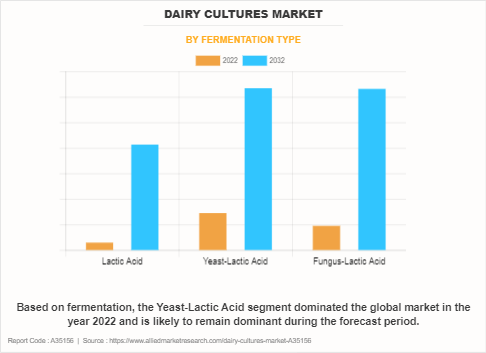
By Type
On the basis of type, the Dairy Culture Industry is classified into mesophilic and thermophilic. The Thermophilic segment dominated the global market in the year 2022 and is likely to remain dominant during the forecast period. Mesophilic enzymes operate optimally at moderate temperatures, typically around room temperature, while thermophilic enzymes function optimally at higher temperatures, often around 50-80°C. The dominance of the thermophilic segment in the global Dairy Culture Industryin 2022 can be attributed to several factors. Thermophilic enzymes are highly stable and active at high temperatures, making them suitable for industrial processes that require elevated temperatures, such as food processing, biofuel production, and bioremediation. Additionally, thermophilic enzymes often exhibit better substrate specificity and higher catalytic efficiency compared to mesophilic enzymes. As industries continue to demand more efficient and sustainable processes, the preference for thermophilic enzymes is likely to persist, driving their dominance in the market during the forecast period. The increasing adoption of thermophilic enzymes in various industrial applications further supports their continued dominance in the global market.
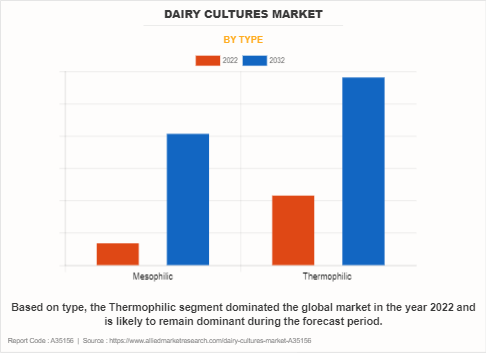
By End User
On the basis of end user, the market is classified into cheese, yogurt, kefir, and others. The cheese segment dominated the global market in the year 2022 and is likely to remain dominant during the forecast period. The popularity of cheese can be attributed to its versatility in culinary applications, appealing taste profiles, and widespread consumer acceptance. As a staple ingredient in various cuisines worldwide, cheese continues to experience robust demand. The sustained dominance of the cheese segment reflects its enduring popularity among consumers and its integral role in the food industry. The forecasted continuity of this trend underscores the enduring consumer preference for cheese, solidifying its position as a key driver in the global dairy market.
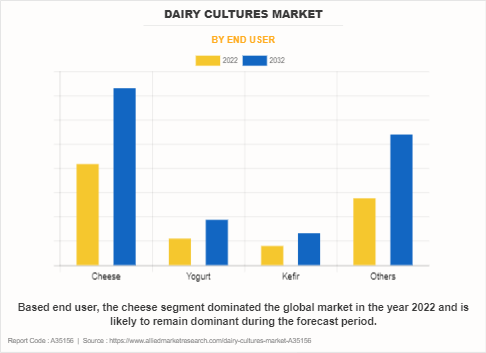
By Region
On the basis of region, the market is subdivided into North America, Europe, Asia-Pacific, Latin America, and Middle East & Africa. The Asia-Pacific region dominated the global market in the year 2022 and is likely to remain dominant during the Dairy Culture Market Forecast period driven by its robust economic growth, technological advancements, and increasing consumer Dairy Culture Market Demand. The region's dominance is expected to persist during the forecast period due to ongoing developments, favorable government policies, and a burgeoning middle class. Companies often tailor their strategies according to regional nuances, making this subdivision crucial for targeted marketing, product positioning, and overall business planning. Understanding regional variations allows stakeholders to make informed decisions and adapt to the diverse market conditions prevalent across the globe.
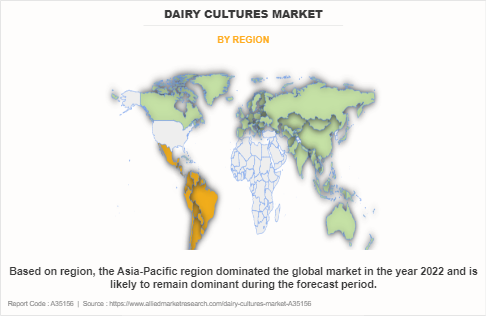
Competitive Analysis
The players operating in the global market have adopted various developmental strategies to increase their Dairy Culture Market Share, gain profitability, and remain competitive in the market. The key players included in the dairy culture market analysis are Fonterra Co-operative Group Limited, Danone SA, Nestlé S.A., Arla Foods Amba, Saputo Inc., Yili Group, Inner Mongolia Yili Industrial Group Co., Ltd., Lactalis Group, Mengniu Dairy Company Limited, Dean Foods Company, Royal Friesland Campina N.V., Kraft Heinz Company, Land O'Lakes, Inc., Sodiaal Cooperative, and Schreiber Foods, Inc.
Key Benefits for Stakeholders
- This report provides a quantitative analysis of the market segments, current trends, estimations, and dynamics of the dairy cultures market analysis from 2022 to 2032 to identify the prevailing Dairy Culture Market Opportunities.
- The market research is offered along with information related to key drivers, restraints, and opportunities.
- Porter's five forces analysis highlights the potency of buyers and suppliers to enable stakeholders make profit-oriented business decisions and strengthen their supplier-buyer network.
- In-depth analysis of the Dairy Culture Market Segmentation assists to determine the prevailing market opportunities.
- Major countries in each region are mapped according to their revenue contribution to the global market.
- Market player positioning facilitates benchmarking and provides a clear understanding of the present position of the market players.
- The report includes the analysis of the regional as well as global Dairy Culture Market Trends, key players, market segments, application areas, and market Dairy Culture Market Growth strategies.
Dairy Cultures Market Report Highlights
| Aspects | Details |
| Forecast period | 2022 - 2032 |
| Report Pages | 249 |
| By End User |
|
| By Fermentation Type |
|
| By Type |
|
| By Region |
|
| Key Market Players | Clover S.A. Proprietary Limited, Grupo Lala, Arla Foods Amba, Dean Foods Company, Hatsun Agro Product Ltd, Saputo Inc., SanCor, foremost farms usa, Fonterra Co-operative Group Limited, Amul |
Analyst Review
The dairy culture market is currently on a trajectory of robust growth, driven by multiple key factors that shape the industry landscape. This growth is primarily fueled by evolving consumer preferences, a heightened awareness of the health benefits associated with dairy products, and the ongoing expansion of global populations.
A pivotal player in this upward trend is the dairy starter culture market. The market report on dairy starter culture provides a comprehensive insight into recent developments, trade regulations, import-export dynamics, production analysis, and the overall industry value. This sector is witnessing a transformative phase with the integration of advanced technologies and innovative production methods. These advancements are not only enhancing operational efficiency but also elevating product quality within the dairy starter culture segment.
Sensory analysis of dairy foods emerges as a critical determinant in shaping market decisions. Major industry players employ extensive testing involving 100 to 500 consumers at various locations to ensure sound decision-making processes. Understanding consumer preferences through sensory analysis provides companies with valuable insights, enabling them to tailor their products effectively to meet the dynamic demands of the market.
The global dairy starter culture market is witnessing noteworthy trends, reflecting the industry's adaptability to changing consumer demands. The introduction of new and diverse products is a strategic response to evolving preferences, and the market's receptiveness to these trends is vital for sustaining growth and competitiveness.
However, the industry is not without its challenges. Fluctuating raw material prices and regulatory complexities pose potential impacts on market dynamics. Industry players must adopt a vigilant and adaptive approach to effectively navigate and mitigate these challenges to ensure sustained growth in the ever-evolving dairy culture market.
The global dairy culture market size was valued at USD 883.2 million in 2022, and is projected to reach USD 1,473.2 million by 2032.
The global dairy culture market is projected to grow at a compound annual growth rate of 5.8% from 2023-2032 to reach USD 1,473.2 million by 2032.
The key players profiled in the reports includes Fonterra Co-operative Group Limited, Dean Foods Company, Clover S.A. Proprietary Limited, Grupo Lala, Arla Foods Amba, foremost farms usa, Hatsun Agro Product Ltd, Amul, SanCor, Saputo Inc.
Asia-Pacific dominated in 2022 and is projected to maintain its leading position throughout the forecast period.
Consumers' increasing interest in health and wellness, Growing trend towards natural and minimally processed foods, Supply chain disruptions, Prevailing health and nutrition trend majorly contribute toward the growth of the market.
Loading Table Of Content...
Loading Research Methodology...



